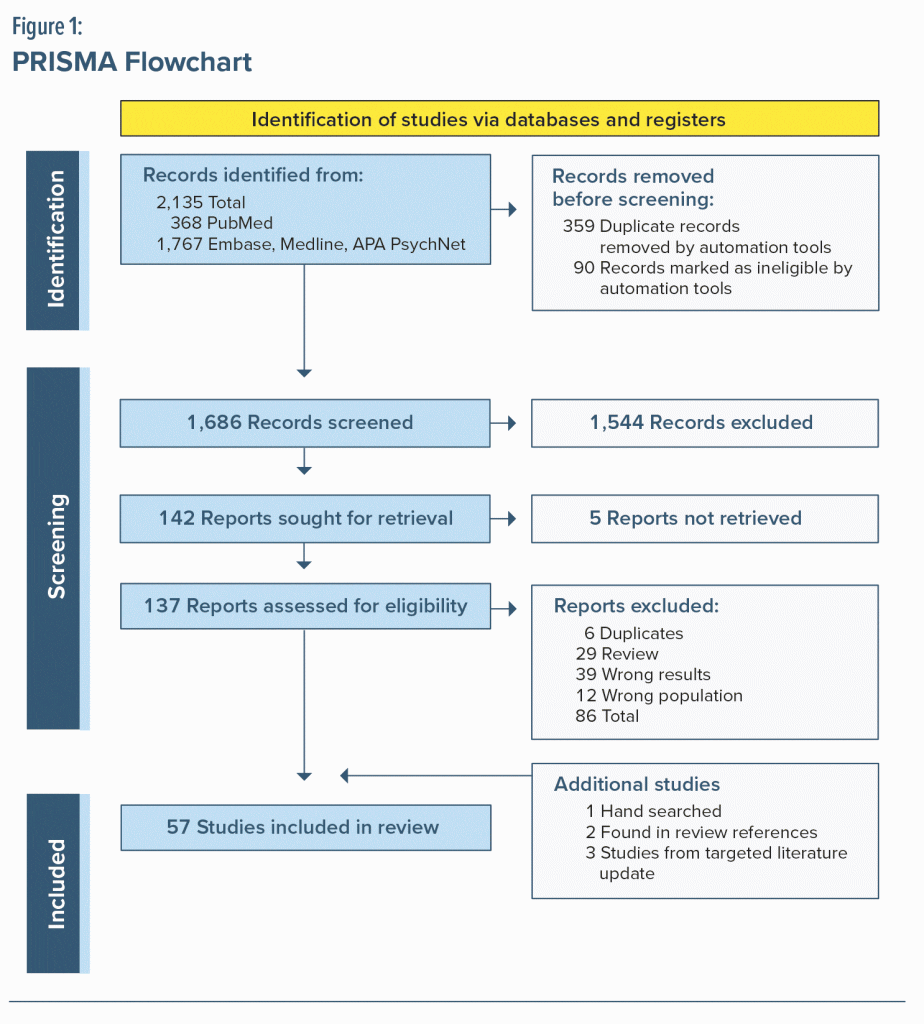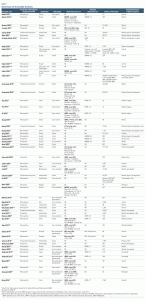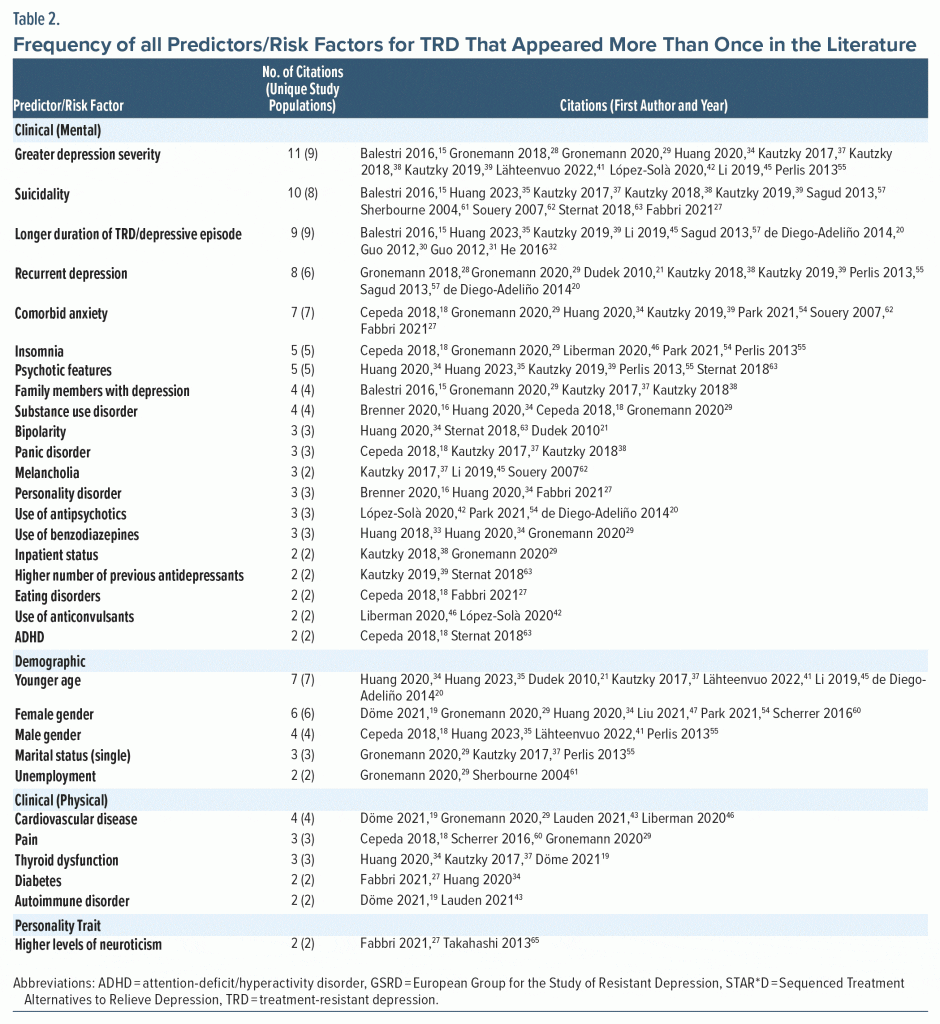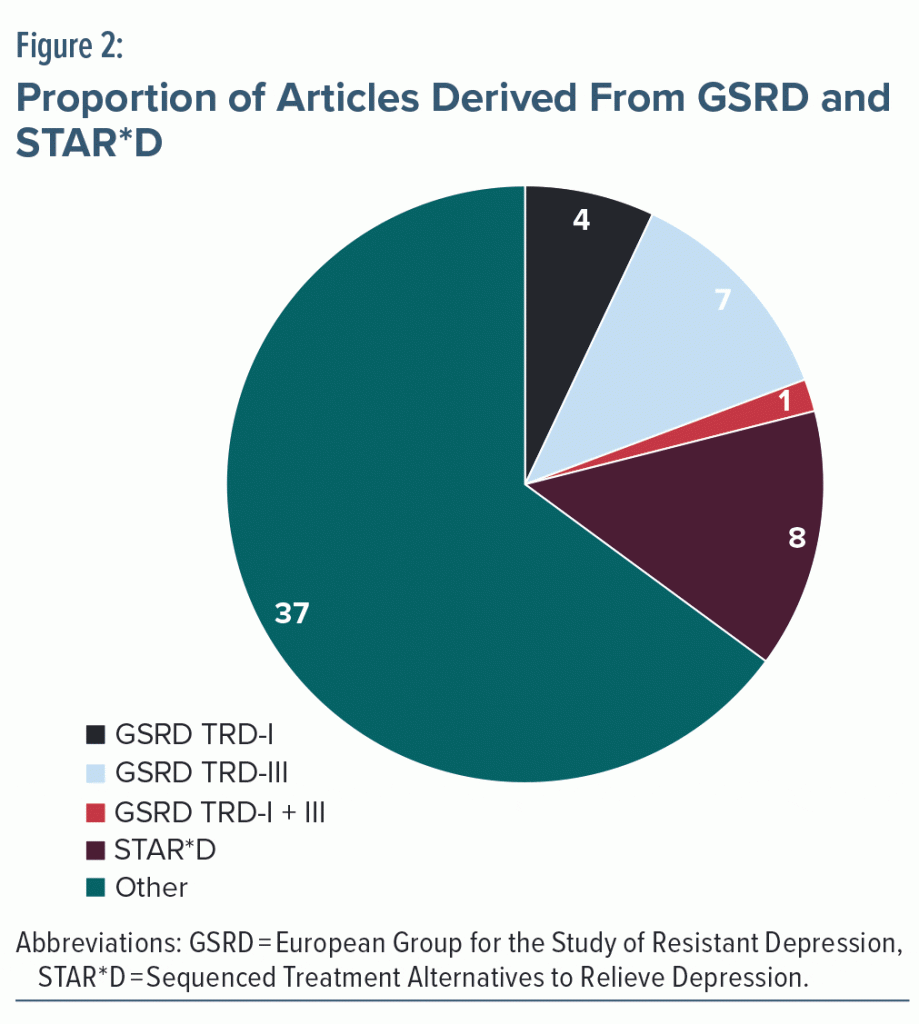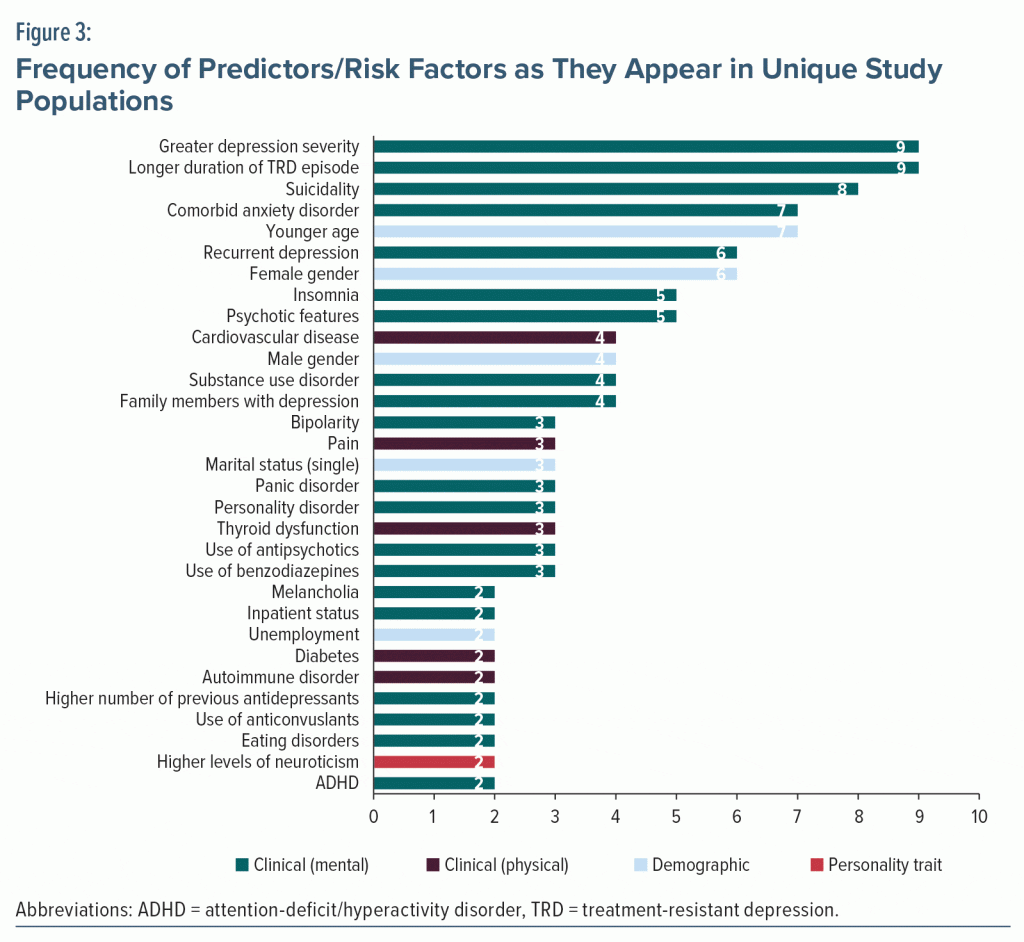ABSTRACT
Objective: To systematically review the literature to identify and categorize the predictors and risk factors for treatment-resistant depression (TRD).
Data Sources: Online databases (PubMed, MEDLINE, Embase, and APA PsycNet) and relevant conference sources were searched from inception up to January 24, 2022. The following keywords were used: treatment-resistant depression, depressive disorder, predictors, risk, and biomarkers.
Study Selection: All studies that included a definition of TRD were included. A total of 1,686 abstracts were screened, and 57 studies were included in the final data synthesis.
Data Extraction: Data were extracted using a data extraction form developed for this study.
Results: The most frequently reported mental predictors/risk factors were greater symptom severity (9 studies), suicidality (8 studies), and recurrent depression (6 studies). Cardiovascular disease (4 studies), pain (3 studies), and thyroid dysfunction (3 studies) were the most common physical predictors/risk factors, while younger age (7 studies) and female gender (6 studies) were the most common demographic predictors/risk factors. Higher levels of neuroticism appeared twice in the literature. Several articles reported on genetic, biological, and imaging variables, but results were too heterogenous to identify common predictors/risk factors.
Conclusions: TRD is a complex disorder with many contributing factors that need to be identified and addressed earlier in the disease course to prevent its development or facilitate better treatment outcomes. Future work should focus on replicating the key predictors/risk factors identified in this review.
J Clin Psychiatry 2024;85(1):23r14885
Author affiliations are listed at the end of this article.
Major depressive disorder (MDD) is a debilitating disease that is characterized by depressed mood, diminished interests, impaired cognitive function, and vegetative symptoms, such as disturbed sleep or appetite.1 In some cases, repeated attempts to treat the disorder fail to help people with depression, resulting in persistent and adverse symptoms. Those who do respond to treatments have a high risk of relapse and further depressive episodes.2 Depression that is not helped after multiple adequate antidepressant treatment is referred to as treatment-resistant depression (TRD).
Though consensus has not been reached on the definition of TRD, the most common definition is characterized by the failure of two prior treatments of adequate dose and duration. A recent systematic literature review illustrated that only 48% of published studies used this definition to identify TRD.3 Using this common definition, TRD is estimated to account for 20%–30% of patients with MDD, affecting 2.8 million people in the US.4 About half of TRD patients cannot perform daily tasks and experience a much lower quality of life. In addition, TRD patients have a higher comorbidity burden, lower work productivity, and higher rates of unemployment and are more likely to receive disability or welfare benefits compared to the general population and to those with MDD without treatment resistance.5,6 The majority of patients seeking pharmacotherapy for MDD are initially started on selective serotonin reuptake inhibitors (SSRIs) or serotonin-norepinephrine reuptake inhibitors (SNRIs) as first and second treatments for MDD.7 According to treatment guidelines, changing classes of medication or augmenting/combining SSRIs/SNRIs with a new class of medication after non-response to the initial classes of antidepressant pharmacotherapy significantly increases response rates.8
Consequently, there is a need for early identification of individuals with MDD who are likely to develop TRD, which would expedite their access to more appropriate treatments, including earlier access to combination/augmentation regimens or specialist therapies such as interventional psychiatric treatment.
In biomedical research, predictors can be used in models to identify individuals at high risk of a particular health condition. These predictors are selected based on their ability to fit data well and explain variance in outcomes, but are not necessarily targets for intervention. On the other hand, risk factors are used in explanatory models to assess the causal relationship between a factor and the occurrence of a disease. These risk factors are potential targets for intervention, as their manipulation can change the outcome. It is important to note that some factors can serve as both predictors and risk factors.9 Predictors/risk factors of TRD may be helpful in multiple ways: first, to enhance understanding of the etiology of the condition; second, to identify patients earlier in their disease trajectory so that they can be offered effective therapies earlier; and third, to identify at-risk individuals for clinical trials of novel interventions for depression before they progress to a TRD state. Taken together, identification of predictors/risk factors of TRD would be a step toward a more predictive, personalized approach to treatment. Such an approach could mitigate unnecessary suffering and cycling through treatments that in some cases do not work and in other cases worsen disease symptomatology.
Several reviews on predictors/risk factors for TRD already exist in the literature. However, the systematic reviews are dated—the most recent was published in 2015.10 A considerable body of work has been added in the interim, particularly observational studies utilizing large databases. The aim of the current study is to systematically review the literature to identify and categorize the predictors/risk factors for TRD and enumerate the most frequently occurring variables.
METHODS
Study Design
A systematic literature review was conducted using the Centre for Reviews and Dissemination guidelines and reported following the Preferred Reporting Items for Systematic Reviews and Meta-Analyses (PRISMA) framework.11,12 This study protocol is registered with the PROSPERO database (registration number: CRD42022299417).
Eligibility Criteria
Eligible articles were observational studies (cross-sectional, case-control, cohort, insurance claims, electronic medical records) and randomized controlled trials that enrolled adults identified with TRD. Interventions could include any pharmacologic, somatic, psychological, and/or digital treatment. Articles were excluded if they were deemed to be reporting on association studies or predictors of treatment response instead of resistance* (wrong results), if they looked at non-TRD populations (wrong population), or if they were review articles. Non–English language publications and qualitative studies were also excluded.
Search Strategy
PubMed, MEDLINE, Embase, and APA PsycNet, along with relevant conference sources, were searched from inception to January 24, 2022. Searches were supported by the EVID AI platform, which, through the use of artificial intelligence and semantic understanding can assist in organizing the articles identified.13 The strategy was based on the following keywords: treatment-resistant depression, depressive disorder, predictors, risk, and biomarkers. The full search strategy is available from the authors on request. Hand searches were used to search the reference lists of any relevant review articles to identify novel studies missed during the initial search. An additional targeted search was conducted in 2023 to identify any new publications from 2022 and 2023.
Study Selection
Following removal of duplicate references, two pairs of authors (L.S.O. and N.H., S.J.O and J.K.) performed title and abstract screening using the Covidence platform. Pilot screening of abstracts was conducted to calibrate the screening process and ensure that all screeners applied the inclusion criteria consistently before the records were split. Full-text articles were then screened (again in pairs) to determine if they met the selection criteria for final inclusion in the review.
Data Extraction
Two pairs of authors (S.J.O and N.H., L.S.O. and J.K.) independently extracted variables of interest using a data extraction form designed specifically for this review. During data extraction, predictors/risk factors were grouped into 8 pre-specified categories: mental health, physical health, demographic, personality, imaging, digital, genetic, and other. A third author mediated any uncertainty associated with extraction. Data extraction was carried out on the Covidence platform and exported to Excel (Microsoft Corporation) for data synthesis.
Data Synthesis
Due to the heterogeneity of the evidence, ie, the inclusion of several study designs, data were analyzed using a narrative synthesis approach. Individual predictors/risk factors identified in the articles were extracted and organized into frequency tables. Each predictor/risk factor extracted into a category was counted as one for that article. Predictors/risk factors that appeared similar were categorized together into distinct groups. For example, if the article reported “musculoskeletal pain” and “back pain” as significant predictors/risk factors, then they were grouped into the “pain” category. If an article reported use of multiple distinct instruments addressing a similar outcome, this was counted as one predictor (ie, the use of the Montgomery-Åsberg Depression Rating Scale [MADRS] and the Hamilton Depression Rating Scale [HDRS] would represent one predictor/risk factor for “depression severity”).
RESULTS
Study Selection
The literature search yielded 1,686 records (after excluding duplicates). Following title and abstract screening, 137 full-text articles were assessed for eligibility, and 57 were included in the systematic review (see Figure 1).
Study Characteristics
Of the 57 articles, all were published between 2002 and 2023; 11 were case-control, 29 were cohort, 10 were cross-sectional, and 7 were non-randomized experimental studies. A summary of these studies is presented in Table 1 (a more in-depth summary table of included articles is available from the authors on request). Fifteen studies were conducted in large observational datasets/registries, with 2 studies including between 100 and 1,000 TRD patients,36,43 6 including between 1,000 and 10,000 TRD patients,19,27,45,46,54,60 and 7 including 10,000-plus TRD patients.16,18,28,29,34,41,47 Of these large observational studies, 4 were conducted in Scandinavian registries,16,28,29,41 6 were conducted in administrative claims,18,19,34,36,47,54 and 2 were conducted using electronic medical records (EMRs)43,60 in linked claims/EMRs.46 Two studies were also conducted using data from the commercial genomics and biotechnology company 23 and me.27,45
Twelve articles reported on findings from the European Group for the Study of Resistant Depression (GSRD)** (see Table 2 for specific GSRD articles). Of the GSRD articles, 4 reported on the TRD-I cohort,22,25,37,62 7 reported on the TRD-III cohort15,23,26,38–40,49 and 1 article reported on both TRD-I and TRD-III.24 Eight studies analyzed data from the Sequenced Treatment Alternatives to Relieve Depression (STAR*D) study† (see Table 2 for specific STAR*D studies). The proportion of studies included in the review from GSRD and STAR*D is illustrated in Figure 2.
In 11 studies, progression to TRD was evaluated prospectively in a clinical setting (labeled “prospective” studies in Table 1), while 8 articles evaluated progression to TRD in a prospective/retrospective manner in large observational databases (labeled “prospective/retrospective” in Table 1). In both the “prospective” and “prospective/retrospective” studies, patients were labeled at baseline as MDD (without TRD) and followed until they either progressed to TRD or remained in a non-TRD MDD state. The study groups then identified risk factors around the time of first-observed MDD diagnosis for those individuals that progressed to a TRD state. The remaining 38 articles were categorized as retrospective and examined the variables that predict the point prevalence of TRD.
Predictors/Risk Factors of TRD
Thirty-two articles reported on mental health–related predictors/risk factors, 13 reported on physical health–related predictors/risk factors, 19 reported on demographic predictors/risk factors, 14 reported on genetic predictors/risk factors, 4 reported on imaging predictors/risk factors, 3 reported on predictors/risk factors related to personality, 5 reported on biological predictors/risk factors, and 7 reported on predictors/risk factors that did not fit into the above categories—which were labeled as “other.” No articles reporting on digital predictors/risk factors were identified. Not all articles reported the predictive performance (area under the receiver operator characteristic curve [aROC], sensitivity, specificity) of the reviewed models. Those that did reported a relatively wide range of area under the curve (AUC) values from 0.68 to 0.89.
Table 2 presents the frequency of all predictors/risk factors that appeared more than once in the literature. The table reflects both the total number of citations in which specific predictors/risk factors were observed and the unique study populations in which they were observed. This distinction is made to avoid double counting predictors from GSRD and STAR*D. Figure 3 presents a graphic representation of predictors/risk factors as they appear in unique study populations.
Mental Health Predictors/Risk Factors
Greater depressive severity ranked as the most frequent mental-health-related predictor/risk factor of TRD and the most frequent overall predictor/risk factor, with 11 appearances in the literature, 9 of which were identified in unique study populations. Four were in GSRD studies, with 2 derived from the TRD-I cohort15,37 and 2 from the TRD-III cohort.38,39 Results from the GSRD demonstrate that patients with severe depression had 2.18-fold higher odds (P = .001) of having TRD than those with mild depression.39 Varied approaches to measuring severity were implemented in the studies. Five studies measured severity using physician-rated instruments, namely, the HDRS.15,37–39,42 Two studies used patient-reported measures such as the Patient Health Questionnaire-9 (PHQ-9) and the Quick Inventory of Depressive Symptomatology (QIDS).45,55 Finally, several studies conducted in large administrative claims databases used International Classification of Disease (ICD) codes to determine severity.28,29,34,41
Suicidality was the second most common predictor/risk factor, with 10 instances in the literature, 8 of which were identified in unique study populations, that positively correlate suicidality with TRD. Several of the studies were GSRD studies and used the Mini-International Neuropsychiatric Interview (MINI), a structured interview conducted by the clinician, to assess suicidality.15,37–39,62,63 This predictor/risk factor is heterogeneous as it contains sources that report on suicide risk, suicidal ideation, and suicide attempts. Suicidal risk assessed by the MINI was associated with a 2.6-fold increased odds (P = .04) of resistance.62 Surprisingly, 1 article reported that patients presenting with suicidal ideation or attempts were at lower risk of developing treatment resistance.46
Longer duration of illness/episodes was the third most prevalent predictor/risk factor with 9 instances, 2 of which were from GSRD studies.15,39 Results from the GSRD demonstrated that an MDD episode lasting more than 3 months confers a 1.85-fold elevated odds (P < .001) of TRD compared to an episode lasting fewer than 3 months.39 This predictor/risk factor is also heterogenous, as it groups total illness and episode duration into one category.
Recurrent depression also appeared 8 times in the literature, 6 of which were identified in unique study populations. Recurrence was measured using ICD-10 codes in 2 studies28,29 and by patient interview in the remaining studies. The risk of progression to TRD is higher for patients with more prior MDD episodes: patients with 4–10 previous episodes have a 1.52-fold elevated odds (P = .031) for TRD, whereas patients with 11+ episodes have a 2.95-fold elevated odds (P = .038) for TRD compared to patients with non-TRD MDD.21
Anxiety disorder was the most frequently observed mental health comorbidity, with 7 instances in the literature. Comorbid anxiety disorder was found to be associated with up to a 4.2-fold increased odds (P < .001) of resistance.62 This finding was contradicted in a study that demonstrated comorbid anxiety lowered the risk of TRD.28 Other mental health comorbidities include insomnia with 5 instances and substance use disorder with 4 instances (1 of which demonstrated lower risk for TRD). Anxiety, insomnia, and substance abuse disorder were largely measured using ICD codes from administrative databases. The following predictors/risk factors appeared 3 times in the literature: panic disorder, melancholia (2 instances of which were identified in unique study populations), bipolarity, personality disorder, use of antipsychotics, and use of benzodiazepines; inpatient status appeared 2 times.
Higher number of previous antidepressants, eating disorders, use of anticonvulsants, and ADHD18,63 appear at the bottom of Table 2 with 2 instances each.
Physical Health Predictors/Risk Factors
Five physical health–related predictors/risk factors were identified. The most frequently reported physical predictor/risk factor of TRD was cardiovascular disease, with 4 instances. Pain appeared in 3 articles. Pain was defined as a broad category including head, neck, abdominal, musculoskeletal, and back pain along with headache, neuropathy, arthritis, and migraine. Pain increased the risk of resistance in the range of 1.06–1.35 times. Thyroid dysfunction was also present in 3 articles. Diabetes and autoimmune disorders both appeared twice in the literature.
Demographic Predictors/Risk Factors
Five demographic predictors/risk factors were identified. The most frequently reported demographic predictor/risk factor was younger age, which appeared in 7 articles. In the reviewed articles, this predictor reflected either younger age during the non-TRD prediction period or early lifetime onset of depression. Additionally, inconsistent definitions were used for age categories, with 1 study defining young age as less than 30 years and another as less than 20 years. Female gender was the second most prevalent predictor/risk factor, with 6 instances in the literature. Contradictory to this finding, male gender appeared in 4 studies as predictive of TRD. Marital status appeared 3 times in the literature. Single status was a predictor of TRD,, whereas marriage was negatively correlated with TRD.55 Finally, unemployment appeared twice as a predictor/risk factor of TRD.
Genetic Predictors/Risk Factors
Fifteen articles reported on genetic predictors/risk factors. Four of these were secondary analyses conducted on both STAR*D and GSRD data. The genetic findings were heterogenous with no predictor/risk factors appearing more than once in the literature. While findings for individual genes seem to be weak and frequently contradictory, pathways of genes linked to biological functions such as neuroplasticity and cell adhesion are much more feasible as predictors of treatment outcome phenotypes and were demonstrated by the GSRD to be reproducible in additional independent data sets.
Biological Predictors/Risk Factors
Five articles reported on biological predictors/risk factors, and as with the genetic articles, no biological predictor/risk factor appeared more than once in the literature. Two articles reported on inflammatory markers. Specifically, higher serum levels of soluble interleukin-6 receptor (sIL-6R) were shown to discriminate treatment-resistant from remitted patients, with sensitivity and specificity of 0.68 and 0.71, respectively. Similarly, high-sensitivity C-reactive protein (hs-CRP) was found to have high accuracy in the diagnosis of TRD. The level of hs-CRP of 10.5 mg/L was the best critical value for the diagnosis of TRD, with sensitivity of 0.92 and specificity of 0.72.
Personality Predictors/Risk Factors
High neuroticism was the only personality-related predictor/risk factor identified, appearing twice. One article noted that low reward dependence and, to a lesser extent, low cooperativeness might be risk factors for TRD.65 In the same population, the presence of high scores for neuroticism and low scores for conscientiousness, openness, and extraversion without shifts in agreeableness on the Revised NEO Personality Inventory (NEO PI-R) was also correlated with poorer prognosis.64
Imaging Predictors/Risk Factors
Four articles reported on imaging predictors/risk factors. The results of these studies were heterogenous due to the use of varying brain imaging techniques, with no predictor appearing more than once. One study reported a structural change, specifically disruptions of white matter microstructure in the fronto-limbic networks, to be linked with treatment resistance.20 Another study focused on functional changes and used the amplitude of low-frequency fluctuations (ALFF) to measure the differences in blood oxygen level–dependent signal detected in functional magnetic resonance imaging (BOLD-fMRI) between TRD, non-TRD, and healthy subjects. Low-frequency fluctuations are thought to be closely related to spontaneous neural activities and physiologically meaningful. That study demonstrated widespread differences in ALFF values among TRD, non-TRD MDD, and healthy subjects throughout the visual recognition circuit (middle temporal gyrus, middle/inferior occipital gyrus, and fusiform), the cerebellum, the “hate circuit” (putamen), the default circuit (anterior cingulate cortex [ACC] and medial frontal gyrus), and the risk/action circuit (inferior frontal gyrus).30,32
DISCUSSION
This study aimed to systematically review the current literature on predictors and risk factors for TRD. A wide range of potential predictors/risk factors were assessed by a relatively small number of studies (57 articles) and can be classified into mental health, physical health, demographic, genetic, biological, personality, imaging, and other. The most frequently occurring predictors/risk factors were recurrent depression, longer duration of illness/episode, insomnia, suicidality, and comorbid anxiety. Repeatedly reported physical health predictors/risk factors included but were not limited to cardiovascular disease, pain, and thyroid dysfunction. Younger age and female gender were the most frequently reported demographic predictors/risk factors. While the review captured several genetic, imaging, and biological predictors/risk factors, the results were heterogenous, and no predictor/risk factor appeared in more than 1 article. No articles on digital predictors/risk factors of TRD were identified.
Of the articles included in the current review, the results from GSRD studies provide the most comprehensive and rigorous insights into TRD predictor/risk factor identification. The GSRD research group identified sets of clinical predictors of TRD common across two large cohorts.34 Symptom severity, suicidal risk, higher number of lifetime depressive episodes, and comorbid anxiety disorder were replicated as the most prominent risk factors for TRD across the two cohorts—with an AUC of 0.86. Indeed, these 4 predictors are within the 5 most frequently reported predictors/risk factors identified in the current review, with further supporting evidence in the literature outside of GSRD studies.
Although anxiety was the most frequently reported comorbidity identified, this review found evidence for several other mental and physical comorbidities assessed by multiple studies. This highlights the importance of thorough evaluation of comorbid psychiatric or general medical disorders in depressed patients. Of note, insomnia was reported by 5 studies and had not been previously identified by the most recent review of TRD predictors.10 Sleep disturbance is common in MDD and has been shown to affect long-term outcomes, including poorer response to antidepressants.70,71 Concomitant treatment of sleep disturbance and depression can enhance outcomes compared with treatment of the depressive disorder alone.72,73
Pain was one of the most frequently reported physical predictors/risk factors. Like sleep disturbance, pain is also common in depression and has been shown to negatively affect adherence to medication, leading to adverse treatment outcomes.74,75 Specifically, results from the STAR*D study demonstrated that MDD patients with physical pain symptoms were less likely to remit and took longer to reach remission when treated with SSRIs.76 Additionally, findings indicate that patients with greater pain severity lived with more severe depression.74 Ketamine, a novel, rapid-acting antidepressant, has been reported to have therapeutic effects in both pain and depressive symptoms.74 However, this treatment is usually reserved for later lines in the depression treatment pathway. Patients experiencing comorbid pain and depression may be suitable candidates for a novel treatment such as ketamine earlier in their treatment journey.
Relatively few articles reporting on biological predictors/risk factors were identified in the current review. The paucity of articles reporting on biological predictors of TRD is in line with findings from a recent review which concluded that although various potential markers for MDD have been identified, the development of biomarkers to predict antidepressant treatment response is still in its infancy.77 Two of the identified articles focused on elevated inflammatory markers that have been well documented in depression. Given the large number of inflammatory and other markers of potential interest, future studies should consider the inclusion of panels of biomarkers in order to improve the predictive power of these factors using an aggregate score.78 Similarly, despite the known links between loneliness, social isolation, and depression,79–81 no articles reported on these societal and interpersonal factors in the context of TRD, highlighting a potential research gap.
The vast majority of included articles were retrospective case-control and cohort studies, many of which report characteristics that are associated with an established TRD state, ie, the patients are already living with the condition. In complex health conditions like TRD, determining the directionality of predictors can be particularly challenging due to the potential for bidirectionality. This bidirectional relationship complicates the interpretation of predictors and requires careful study design and consideration of potential confounding factors. Nineteen articles were categorized as either “prospective” or “prospective/retrospective,” which sought to identify patients with MDD who are at elevated risk for developing TRD in the future, highlighting potential “early warning” signals for TRD. Articles labeled “prospective” were conducted in a clinical setting, while those labeled “prospective/retrospective” represent large observational studies, ie, electronic medical records, administrative claims, and registries. Studies conducted in large administrative databases were included in the review as they provide valuable insights into real-world patterns and associations, which can be informative for hypothesis generation and further research. These studies are often used to identify associations between variables, rather than establishing causality, and may be subject to data entry errors, inconsistencies, and other biases. However, they can still provide valuable information on potential predictors/risk factors of TRD such as comorbidities and demography in large, diverse populations.
Identification of “early warning” signals will aid in establishing more targeted, rapid, and efficacious treatment algorithms for MDD. Such treatments could include those reserved for later lines of treatment, ie, augmentation or brain stimulation therapies. No prospective study allocating patients at risk to respective treatment arms, either based on the predictors/risk factors highlighted here or by other advanced statistical algorithms, has been performed so far. This represents a current evidence gap, and further prospective studies are clearly needed to validate any predictors/risk factors of treatment resistance identified in the literature. Longitudinal studies, in which data are collected over time, can be particularly useful in determining the directionality of predictors in complex health conditions.
The current review allowed for broad patient population capture by including “Adults identified with treatment-resistant depression.” In contrast, a previous systematic review by Bennabi et al10 described population inclusion as “inclusion of a unipolar depressed group with operationally defined resistance to treatments as a failure of two subsequent antidepressant therapies”(p138) and captured far fewer (8) articles in their review. Given the diverse nature of the studies identified in the current review, treatment resistance was determined in several ways. Of note, only ~50% of articles in the current review met the FDA definition of TRD: “Failure to respond to two or more antidepressant regimens despite adequate dose and duration and adherence to treatment within the current MDD episode.”85 This is in keeping with previous evidence that no consensus definition exists for TRD, with only 48% of interventional studies meeting the most frequently specified criteria for TRD.3 Furthermore, many of the studies in the current review did not specify that the two antidepressant courses of adequate/duration were administered within the same episode. When a stricter approach was implemented, requiring explicit mention of within the same episode, just ~14% of articles aligned with this definition. These varying distinctions and definitions are an inherent limitation of the field of depression treatment resistance research but are essential to consider when interpreting results and drawing conclusions from the literature. A limitation inherent in the evidence presented in the current review is the heterogeneity of data collection (self-report versus clinician-rated) and analytic methods used, and of the effect sizes reported, which impedes efforts to aggregate findings across studies. Additionally, not all studies reported the performance (aROC, sensitivity, specificity) of the predictive models. Those that did, reported a relatively wide range of AUC values from 0.68 to 0.89. The AUC has relevance for the clinical utility of predictive models and should be considered when interpreting the findings of the current review. Without quantitative synthesis of standard effect sizes via methods such as meta-analysis, it is difficult to establish how important any predictor/risk factor identified may be in the clinical setting.
Finally, systematic reviews commonly include an assessment of the risk of bias. The heterogeneity of the studies and the observational qualities of most study designs meant that an assessment of bias was not appropriate. Therefore, this systematic review was not able to adhere to some of the PRISMA guidelines and protocols.
In conclusion, this review has identified a variety of different predictors/risk factors of TRD from multiple areas, including mental health, physical health, demographic, genetic, biological, personality, and imaging predictors. These findings highlight that TRD is a complex disorder with many contributing factors that may need to be identified and addressed earlier in the disease course to prevent the development of TRD or facilitate better treatment outcomes. In line with the limitations discussed, future work should focus on replicating the key predictors identified here using uniform definitions of TRD, focusing on resistance rather than response, and with data appropriate for synthesis. Furthermore, the absence of digital predictors despite significant advances in digital health highlights the importance of leveraging existing technologies and fostering their development.
*Including articles that investigate predictors of response to treatment would lead to the inclusion of patients that may positively respond to future treatment. That patient population is the inverse of patients at risk of TRD and was not included in the current review.
**Since 1999, the GSRD has initiated and coordinated collaborative research programs in eight European countries (Austria, Belgium, France, Germany, Greece, Israel, Italy, and Switzerland), in which three consecutive research projects (TRD I, TRD II, and TRD III) were carried out. The GSRD has aimed to establish appropriate methodological and operational criteria for the definition of antidepressant treatment response and TRD. For a more in-depth overview of the GSRD project, please see Bartova et al (2019).83
†The STAR*D trial is the largest and most consequential antidepressant study ever conducted. The overall goal of the STAR*D trial was to assess the effectiveness of depression treatments in patients diagnosed with major depressive disorder in both primary and specialty care settings. Please see Rush et al (2006)84 for a more detailed overview of the STAR*D study.
Article Information
Published Online: November 13, 2023. https://doi.org/10.4088/JCP.23r14885
© 2023 Physicians Postgraduate Press, Inc.
Submitted: April 18, 2023; accepted September 18, 2023.
To Cite: O’Connor SJ, Hewitt N, Kuc J, et al. Predictors and risk factors of treatment-resistant depression: a systematic review. J Clin Psychiatry. 2024;85(1):23r14885
Author Affiliations: COMPASS Pathfinder PLC, London, United Kingdom (all authors).
Corresponding Author: Shane O’Connor, MSc, COMPASS Pathfinder Limited, Fora – Soho, 33 Broadwick Street, London, W1F 0DQ, United Kingdom ([email protected]).
Relevant Financial Relationships: All authors are employees of COMPASS Pathfinder PLC.
Funding/Support: This research was funded in full by COMPASS Pathfinder PLC.
Role of the Funders/Sponsors: COMPASS Pathfinder PLC was involved at all stages of searching, screening, data synthesis, manuscript drafting, and review.
Acknowledgments: The authors would like to thank Tiffany Chow PharmD (Genesis Research), supported by COMPASS Pathfinder PLC, for assistance in devising and running the search strategy at the onset of the review. Additionally, the authors would like to thank the following COMPASS Pathfinder PLC employees for reviewing and providing input into the manuscript: Jason Lerner, MSc; Lindsey Marwood, PhD; and Joyce Tsai, PhD.
Additional Information: A protocol for this review was registered on Prospero (ID CRD42022299417).
ORCID: Shane J. O’Connor: https://orcid.org/0000-0003-3042-2450; Nilay Hewitt: https://orcid.org/0000-0002-5980-1457; Joanna Kuc: https://orcid.org/0000-0003-4159-7176
Clinical Points
- Identification of predictors/risk factors of treatment-resistant depression (TRD) could offer opportunities toward more predictive, personalized treatment approaches.
- Clinicians may find it beneficial to monitor these predictors/risk factors and consider early interventions. Doing so could potentially influence the onset of TRD and therapeutic results. However, understanding the individual nuances, such as genetic and biological factors, remains complex, and further research may help in refining treatment approaches.
References (85)

- Otte C, Gold SM, Penninx BW, et al. Major depressive disorder. Nat Rev Dis Primers. 2016;2(1):16065. PubMed CrossRef
- Johnston KM, Powell LC, Anderson IM, et al. The burden of treatment-resistant depression: a systematic review of the economic and quality of life literature. J Affect Disord. 2019;242:195–210. PubMed CrossRef
- Gaynes BN, Lux L, Gartlehner G, et al. Defining treatment-resistant depression. Depress Anxiety. 2020;37(2):134–145. PubMed CrossRef
- Zhdanava M, Pilon D, Ghelerter I, et al. The prevalence and national burden of treatment-resistant depression and major depressive disorder in the United States. J Clin Psychiatry. 2021;82(2):20m13699. PubMed CrossRef
- Jaffe DH, Rive B, Denee TR. The humanistic and economic burden of treatment-resistant depression in Europe: a cross-sectional study. BMC Psychiatry. 2019;19(1):247. PubMed CrossRef
- Orsini LS, O’Connor SJ, Mohwinckel MT, et al. Observational study to characterize treatment-resistant depression in Germany, France and the United Kingdom: analysis of real-world data collected through a survey of healthcare professionals. Curr Med Res Opin. 2022;38(12):2219–2226. PubMed CrossRef
- Hripcsak G, Ryan PB, Duke JD, et al. Characterizing treatment pathways at scale using the OHDSI network. Proc Natl Acad Sci U S A. 2016;113(27):7329–7336. PubMed CrossRef
- Denee T, Kerr C, Ming T, et al. Current treatments used in clinical practice for major depressive disorder and treatment resistant depression in England: A retrospective database study. J Psychiatr Res. 2021;139:172–178. PubMed CrossRef
- Schooling CM, Jones HE. Clarifying questions about “risk factors”: predictors versus explanation. Emerg Themes Epidemiol. 2018;15(1):10. PubMed CrossRef
- Bennabi D, Aouizerate B, El-Hage W, et al. Risk factors for treatment resistance in unipolar depression: a systematic review. J Affect Disord. 2015;171:137–141. PubMed CrossRef
- Tacconelli E. Systematic reviews: CRD’s guidance for undertaking reviews in health care. Lancet Infect Dis. 2010;10(4):226. CrossRef
- Page MJ, McKenzie JE, Bossuyt PM, et al. The PRISMA 2020 statement: an updated guideline for reporting systematic reviews. BMJ. 2021;372:n71. PubMed CrossRef
- Genesis Research Group. EVID AI. https://genesisrg.com/evidai
- Anttila S, Huuhka K, Huuhka M, et al. Interaction between 5-HT1A and BDNF genotypes increases the risk of treatment-resistant depression. J Neural Transm (Vienna). 2007;114(8):1065–1068. PubMed CrossRef
- Balestri M, Calati R, Souery D, et al. Socio-demographic and clinical predictors of treatment resistant depression: A prospective European multicenter study. J Affect Disord. 2016;189:224–232. PubMed CrossRef
- Brenner P, Brandt L, Li G, et al. Substance use disorders and risk for treatment resistant depression: a population-based, nested case-control study. Addiction. 2020;115(4):768–777. PubMed CrossRef
- Carvalho S, Santos M, Lima L, et al. IL6-174G > C genetic polymorphism influences antidepressant treatment outcome. Nord J Psychiatry. 2017;71(2):158–162. PubMed CrossRef
- Cepeda MS, Reps J, Ryan P. Finding factors that predict treatment-resistant depression: Results of a cohort study. Depress Anxiety. 2018;35(7):668–673. PubMed CrossRef
- Döme P, Kunovszki P, Takács P, et alHashimoto K, ed. Clinical characteristics of treatment-resistant depression in adults in Hungary: Real-world evidence from a 7-year-long retrospective data analysis. PLoS One. 2021;16(1):e0245510. PubMed CrossRef
- de Diego-Adeliño J, Pires P, Gómez-Ansón B, et al. Microstructural white-matter abnormalities associated with treatment resistance, severity and duration of illness in major depression. Psychol Med. 2014;44(6):1171–1182. PubMed CrossRef
- Dudek D, Rybakowski JK, Siwek M, et al. Risk factors of treatment resistance in major depression: association with bipolarity. J Affect Disord. 2010;126(1–2):268–271. PubMed CrossRef
- Fabbri C, Crisafulli C, Gurwitz D, et al. Neuronal cell adhesion genes and antidepressant response in three independent samples. Pharmacogenomics J. 2015;15(6):538–548. PubMed CrossRef
- Fabbri C, Crisafulli C, Calati R, et al. Neuroplasticity and second messenger pathways in antidepressant efficacy: pharmacogenetic results from a prospective trial investigating treatment resistance. Eur Arch Psychiatry Clin Neurosci. 2017;267(8):723–735. PubMed CrossRef
- Fabbri C, Corponi F, Albani D, et al. Pleiotropic genes in psychiatry: Calcium channels and the stress-related FKBP5 gene in antidepressant resistance. Prog Neuropsychopharmacol Biol Psychiatry. 2018;81:203–210. PubMed CrossRef
- Fabbri C, Kasper S, Kautzky A, et al. Genome-wide association study of treatment-resistance in depression and meta-analysis of three independent samples. Br J Psychiatry. 2019;214(1):36–41. PubMed CrossRef
- Fabbri C, Kasper S, Kautzky A, et al. A polygenic predictor of treatment-resistant depression using whole exome sequencing and genome-wide genotyping. Transl Psychiatry. 2020;10(1):50. PubMed CrossRef
- Fabbri C, Hagenaars SP, John C, et al. Genetic and clinical characteristics of treatment-resistant depression using primary care records in two UK cohorts. Mol Psychiatry. 2021;26(7):3363–3373. PubMed CrossRef
- Gronemann FH, Jorgensen MB, Nordentoft M, et al. Incidence of, risk factors for, and changes over time in treatment-resistant depression in Denmark: a register-based cohort study. J Clin Psychiatry. 2018;79(4):17m11845. PubMed CrossRef
- Gronemann FH, Jorgensen MB, Nordentoft M, et al. Socio-demographic and clinical risk factors of treatment-resistant depression: a Danish population-based cohort study. J Affect Disord. 2020;261:221–229. PubMed CrossRef
- Guo WB, Liu F, Xue ZM, et al. Alterations of the amplitude of low-frequency fluctuations in treatment-resistant and treatment-response depression: a resting-state fMRI study. Prog Neuropsychopharmacol Biol Psychiatry. 2012;37(1):153–160. PubMed CrossRef
- Guo WB, Liu F, Chen JD, et al. Abnormal neural activity of brain regions in treatment-resistant and treatment-sensitive major depressive disorder: a resting-state fMRI study. J Psychiatr Res. 2012;46(10):1366–1373. PubMed CrossRef
- He Z, Cui Q, Zheng J, et al. Frequency-specific alterations in functional connectivity in treatment-resistant and -sensitive major depressive disorder. J Psychiatr Res. 2016;82:30–39. PubMed CrossRef
- Huang MH, Chen MH, Tu PC, et al. Elevated tumor necrosis factor-alpha receptor subtype 1 and the association with abnormal brain function in treatment-resistant depression. J Affect Disord. 2018;235:250–256. PubMed CrossRef
- Huang SS, Chen HH, Wang J, et al. Investigation of early and lifetime clinical features and comorbidities for the risk of developing treatment-resistant depression in a 13-year nationwide cohort study. BMC Psychiatry. 2020;20(1):541. PubMed CrossRef
- Huang Y, Sun P, Wu Z, et al. Comparison on the clinical features in patients with or without treatment-resistant depression: a National Survey on Symptomatology of Depression report. Psychiatry Res. 2023;319:114972. PubMed CrossRef
- Jeng JS, Li CT, Chen MH, et al. Repeated low-grade infections predict antidepressant-resistant depression: a nationwide population-based cohort study. J Clin Psychiatry. 2018;79(1):17m11540. PubMed CrossRef
- Kautzky A, Baldinger-Melich P, Kranz GS, et al. A new prediction model for evaluating treatment-resistant depression. J Clin Psychiatry. 2017;78(2):215–222. PubMed CrossRef
- Kautzky A, Dold M, Bartova L, et al. Refining prediction in treatment-resistant depression: results of machine learning analyses in the TRD III Sample. J Clin Psychiatry. 2018;79(1):16m11385. PubMed CrossRef
- Kautzky A, Dold M, Bartova L, et al. Clinical factors predicting treatment resistant depression: affirmative results from the European multicenter study. Acta Psychiatr Scand. 2019;139(1):78–88. PubMed CrossRef
- Kraus C, Kautzky A, Watzal V, et al. Body mass index and clinical outcomes in individuals with major depressive disorder: findings from the GSRD European Multicenter Database. J Affect Disord. 2023;335:349–357. PubMed CrossRef
- Lähteenvuo M, Taipale H, Tanskanen A, et al. Courses of treatment and risk factors for treatment-resistant depression in Finnish primary and special healthcare: A nationwide cohort study. J Affect Disord. 2022;308:236–242. PubMed CrossRef
- López-Solà C, Subirà M, Serra-Blasco M, et al. Is cognitive dysfunction involved in difficult-to-treat depression? Characterizing resistance from a cognitive perspective. Eur Psychiatry. 2020;63(1):e74. PubMed CrossRef
- Lauden A, Geishin A, Merzon E, et al. Higher rates of allergies, autoimmune diseases and low-grade inflammation markers in treatment-resistant major depression. Brain Behav Immun Health. 2021;16:100313. PubMed CrossRef
- Li Z, Zhang Y, Wang Z, et al. The role of BDNF, NTRK2 gene and their interaction in development of treatment-resistant depression: data from multicenter, prospective, longitudinal clinic practice. J Psychiatr Res. 2013;47(1):8–14. PubMed CrossRef
- Li QS, Tian C, McIntyre MH, et al; 23andMe Research Team. Phenotypic analysis of 23andMe survey data: Treatment-resistant depression from participants’ perspective. Psychiatry Res. 2019;278:173–179. PubMed CrossRef
- Liberman JN, Davis T, Pesa J, et al. Predicting incident treatment-resistant depression: a model designed for health systems of care. J Manag Care Spec Pharm. 2020;26(8):987–995. PubMed CrossRef
- Liu X, Mukai Y, Furtek CI, et al. Epidemiology of treatment-resistant depression in the United States. J Clin Psychiatry. 2021;83(1):21m13964. PubMed CrossRef
- Maes M, Mihaylova I, Kubera M, et al. Lower plasma Coenzyme Q10 in depression: a marker for treatment resistance and chronic fatigue in depression and a risk factor to cardiovascular disorder in that illness. Neuroendocrinol Lett. 2009;30(4):462–469. PubMed
- Mandelli L, Serretti A, Souery D, et al. High occupational level is associated with poor response to the treatment of depression: a replication study. Eur Neuropsychopharmacol. 2016;29(3):349–355. PubMed CrossRef
- Milanesi E, Bonvicini C, Congiu C, et al. The role of GRIK4 gene in treatment-resistant depression. Genet Res. 2015;97:e14. PubMed CrossRef
- Minelli A, Magri C, Barbon A, et al. Proteasome system dysregulation and treatment resistance mechanisms in major depressive disorder. Transl Psychiatry. 2015;5(12):e687. PubMed CrossRef
- Nie Z, Vairavan S, Narayan VA, et al; Branchi I, ed. Predictive modeling of treatment resistant depression using data from STAR*D and an independent clinical study. PLoS One. 2018;13(6):e0197268. PubMed CrossRef
- O’Dushlaine C, Ripke S, Ruderfer DM, et al. Rare copy number variation in treatment-resistant major depressive disorder. Biol Psychiatry. 2014;76(7):536–541. PubMed CrossRef
- Park H, Park CM, Woo JM, et al. Real-world data analysis of the clinical and economic burden and risk factors in patients with major depressive disorder with an inadequate response to initial antidepressants. J Med Econ. 2021;24(1):589–597. PubMed CrossRef
- Perlis RH. A clinical risk stratification tool for predicting treatment resistance in major depressive disorder. Biol Psychiatry. 2013;74(1):7–14. PubMed CrossRef
- Petersen T, Hughes M, Papakostas GI, et al. Treatment-resistant depression and Axis II comorbidity. Psychother Psychosom. 2002;71(5):269–274. PubMed CrossRef
- Sagud M, Mihaljevic-Peles A, Uzun S, et al. The lack of association between components of metabolic syndrome and treatment resistance in depression. Psychopharmacology (Berl). 2013;230(1):15–21. PubMed CrossRef
- Santos M, Carvalho S, Lima L, et al. The role of IL18-607C>A and IL18-137G>C promoter polymorphisms in antidepressant treatment phenotypes: A preliminary report. Neurosci Lett. 2016;622:107–112. PubMed CrossRef
- Santos M, Carvalho S, Lima L, et al. FAS -670A>G genetic polymorphism is associated with treatment resistant depression. J Affect Disord. 2015;185:164–169. PubMed CrossRef
- Scherrer JF, Salas J, Sullivan MD, et al. The influence of prescription opioid use duration and dose on development of treatment resistant depression. Prev Med. 2016;91:110–116. PubMed CrossRef
- Sherbourne C, Schoenbaum M, Wells KB, et al. Characteristics, treatment patterns, and outcomes of persistent depression despite treatment in primary care. Gen Hosp Psychiatry. 2004;26(2):106–114. PubMed CrossRef
- Souery D, Oswald P, Massat I, et al; Group for the Study of Resistant Depression. Clinical factors associated with treatment resistance in major depressive disorder: results from a European multicenter study. J Clin Psychiatry. 2007;68(7):1062–1070. PubMed CrossRef
- Sternat T, Fotinos K, Fine A, et al. Low hedonic tone and attention-deficit hyperactivity disorder: risk factors for treatment resistance in depressed adults. Neuropsychiatr Dis Treat. 2018;14:2379–2387. PubMed CrossRef
- Takahashi M, Shirayama Y, Muneoka K, et al; Yoshikawa T, ed. Low openness on the revised NEO personality inventory as a risk factor for treatment-resistant depression. PLoS One. 2013;8(9):e71964. PubMed CrossRef
- Takahashi M, Shirayama Y, Muneoka K, et al; Yoshikawa T, ed. Personality traits as risk factors for treatment-resistant depression. PLoS One. 2013;8(5):e63756. PubMed CrossRef
- Wang Y, Li S, Niu L, et al. Polymorphisms of COMT and CREB1 are associated with treatment-resistant depression in a Chinese Han population. J Neural Transm (Vienna). 2022;129(1):85–93. PubMed CrossRef
- Wu X, Dai B, Yan F, et al. Serum cortisol, nesfatin-1, and IL-1β: potential diagnostic biomarkers in elderly patients with treatment-resistant depression. Clin Interv Aging. 2022;17:567–576. PubMed CrossRef
- Yamasaki K, Hasegawa T, Takeda M. Serum level of soluble interleukin 6 receptor is a useful biomarker for identification of treatment-resistant major depressive disorder. Neuropsychopharmacol Rep. 2020;40(2):130–137. PubMed CrossRef
- Zhang C, Li Z, Wu Z, et al. A study of N-methyl-d-aspartate receptor gene (GRIN2B) variants as predictors of treatment-resistant major depression. Psychopharmacology (Berl). 2014;231(4):685–693. PubMed CrossRef
- Bei B, Asarnow LD, Krystal A, et al. Treating insomnia in depression: Insomnia related factors predict long-term depression trajectories. J Consult Clin Psychol. 2018;86(3):282–293. PubMed CrossRef
- Troxel WM, Kupfer DJ, Reynolds CF 3rd, et al. Insomnia and objectively measured sleep disturbances predict treatment outcome in depressed patients treated with psychotherapy or psychotherapy-pharmacotherapy combinations. J Clin Psychiatry. 2012;73(4):478–485. PubMed CrossRef
- Fava M, McCall WV, Krystal A, et al. Eszopiclone co-administered with fluoxetine in patients with insomnia coexisting with major depressive disorder. Biol Psychiatry. 2006;59(11):1052–1060. PubMed CrossRef
- Manber R, Edinger JD, Gress JL, et al. Cognitive behavioral therapy for insomnia enhances depression outcome in patients with comorbid major depressive disorder and insomnia. Sleep. 2008;31(4):489–495. PubMed CrossRef
- Lan X, Zhou Y, Wang C, et al. Pre-treatment pain symptoms influence antidepressant response to ketamine in depressive patients. Front Psychiatry. 2022;13:793677. PubMed CrossRef
- Agüera-Ortiz L, Failde I, Mico JA, et al. Pain as a symptom of depression: prevalence and clinical correlates in patients attending psychiatric clinics. J Affect Disord. 2011;130(1-2):106–112. PubMed CrossRef
- Leuchter AF, Husain MM, Cook IA, et al. Painful physical symptoms and treatment outcome in major depressive disorder: a STAR*D (Sequenced Treatment Alternatives to Relieve Depression) report. Psychol Med. 2010;40(2):239–251. PubMed CrossRef
- Busch Y, Menke A. Blood-based biomarkers predicting response to antidepressants. J Neural Transm (Vienna). 2019;126(1):47–63. PubMed CrossRef
- Schmidt HD, Shelton RC, Duman RS. Functional biomarkers of depression: diagnosis, treatment, and pathophysiology. Neuropsychopharmacology. 2011;36(12):2375–2394. PubMed CrossRef
- Lee SL, Pearce E, Ajnakina O, et al. The association between loneliness and depressive symptoms among adults aged 50 years and older: a 12-year population-based cohort study. Lancet Psychiatry. 2021;8(1):48–57. PubMed CrossRef
- van Winkel M, Wichers M, Collip D, et al. Unraveling the role of loneliness in depression: the relationship between daily life experience and behavior. Psychiatry. 2017;80(2):104–117. PubMed CrossRef
- Taylor HO, Taylor RJ, Nguyen AW, et al. Social isolation, depression, and psychological distress among older adults. J Aging Health. 2018;30(2):229–246. PubMed CrossRef
- Qiao J, Geng D, Qian L, et al. Correlation of clinical features with hs-CRP in TRD patients. Exp Ther Med. 2019;17(1):344–348. Published online Nov 1, 2018. PubMed CrossRef
- Bartova L, Dold M, Kautzky A, et al. Results of the European Group for the Study of Resistant Depression (GSRD) - basis for further research and clinical practice. World J Biol Psychiatry. 2019;20(6):427–448. PubMed CrossRef
- Rush AJ, Trivedi MH, Wisniewski SR, et al. Acute and longer-term outcomes in depressed outpatients requiring one or several treatment steps: a STAR*D report. Am J Psychiatry. 2006;163(11):1905–1917. PubMed CrossRef
- US Food and Drug Administration, Center for Drug Evaluation and Research. Major Depressive Disorder: Developing Drugs for Treatment. Silver Spring, Maryland: US Food and Drug Administration; 2018.
This PDF is free for all visitors!
Save
Cite
